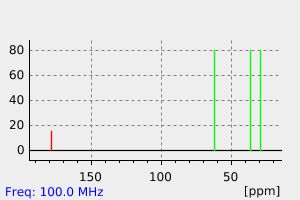γ-hydroxybutyrate | 692-28-4
-
物化性质
-
计算性质
-
ADMET
-
安全信息
-
SDS
-
制备方法与用途
-
上下游信息
-
文献信息
-
表征谱图
-
同类化合物
-
相关功能分类
-
相关结构分类
计算性质
-
辛醇/水分配系数(LogP):0
-
重原子数:7
-
可旋转键数:2
-
环数:0.0
-
sp3杂化的碳原子比例:0.75
-
拓扑面积:60.4
-
氢给体数:1
-
氢受体数:3
ADMET
反应信息
-
作为反应物:描述:参考文献:名称:人羟酸-氧酸转氢酶的动力学表征:与D-2-羟基戊二酸和γ-羟基丁酸尿症的相关性。摘要:我们研究了羟酸-草酸转氢酶(HOT)的存在,该酶可催化不依赖辅因子的γ-羟基丁酸酯(GHB)转化为琥珀酸半醛,再将2-酮戊二酸(2-KG)还原为D-2-羟基戊二酸(D (-2-HG),以[2H6] GHB和2-KG为底物在人肝提取物中。我们使用GC-MS分析测量了D- [2H] 2-HG中2H的掺入,为人类的HOT活性提供了证据。HOT的动力学表征是在正向和反向进行的。为了研究来自D-2-羟基戊二酸尿症患者的培养人成纤维细胞的HOT活性测定,我们使用了[2H6] GHB和[2H4] 2-KG作为共底物。在该系统中,通过测量D- [2H5] 2-HG的产生来量化HOT活性。D-2-羟基戊二酸尿症患者的成纤维细胞显示出正常的HOT活性。我们的结果提供了人类组织中HOT活性的首次证明和初步动力学表征。DOI:10.1007/s10545-005-0114-x
-
作为产物:描述:参考文献:名称:Barton, Patrick; Laws, Andrew P.; Page, Michael I., Journal of the Chemical Society. Perkin transactions II, 1994, # 9, p. 2021 - 2030摘要:DOI:
文献信息
-
COPOLYMER COMPRISING 4-HYDROXYBUTYRATE UNIT AND LACTATE UNIT AND ITS MANUFACTURING METHOD申请人:Park Si-Jae公开号:US20100222545A1公开(公告)日:2010-09-02The present invention relates to a copolymer comprising 4-hydroxybutyrate monomer unit and lactate monomer unit, a copolymer 4-hydroxybutyrate monomer unit, lactate monomer unit and 3-hydroxyalkanoate, or their preparing method. More specifically, the present invention relates to a method for preparing a copolymer comprising lactate monomer; 4-hydroxybutyrate monomer; and optionally 3-hydroxyalkanoate, wherein the method comprises culturing a cell or plant comprising the gene of enzyme converting lactate and 3-hydroxyalkanoate into lactyl-CoA and 3-hydroxyalkanoyl-CoA, respectively, phosphotransbutylase gene, butyrate kinase gene and polyhydroxyalkanoate synthase gene together, and the copolymer made by the method. The copolymer of the present invention is a biodegradable polymer being able to be usefully used instead of conventional synthetic plastic, and the copolymer can be used for medical use.
-
Copolymer comprising 4-hydroxybutyrate unit and lactate unit and its manufacturing method申请人:Park Si-Jae公开号:US08383379B2公开(公告)日:2013-02-26The present invention relates to a copolymer comprising 4-hydroxybutyrate monomer unit and lactate monomer unit, a copolymer 4-hydroxybutyrate monomer unit, lactate monomer unit and 3-hydroxyalkanoate, or their preparing method. More specifically, the present invention relates to a method for preparing a copolymer comprising lactate monomer; 4-hydroxybutyrate monomer; and optionally 3-hydroxyalkanoate, wherein the method comprises culturing a cell or plant comprising the gene of enzyme converting lactate and 3-hydroxyalkanoate into lactyl-CoA and 3-hydroxyalkanoyl-CoA, respectively, phosphotransbutylase gene, butyrate kinase gene and polyhydroxyalkanoate synthase gene together, and the copolymer made by the method. The copolymer of the present invention is a biodegradable polymer being able to be usefully used instead of conventional synthetic plastic, and the copolymer can be used for medical use.
-
Kinetics aspects of Gamma-hydroxybutyrate dehydrogenase作者:Esther S. Taxon、Lila P. Halbers、Stanley M. ParsonsDOI:10.1016/j.bbapap.2020.140376日期:2020.5metabolically related enzymes, the Group III family of Fe2+-dependent alcohol dehydrogenases (ADHs) and the separate subfamily of nucleoside diphosphates linked to x (nudix) hydrolases that activate Group III ADHs are under-characterized. Here we report the steady-state initial-velocity forward direction (alcohol → aldehyde) reaction of a Group III ADH, namely gamma-hydroxybutyrate dehydrogenase (GHBDH, UniProt:两组代谢相关的酶,Fe 2+依赖性酒精脱氢酶(ADHs)的III组家族和与激活III组ADH的x(nudix)水解酶连接的核苷二磷酸的单独亚家族,功能不足。在这里,我们报道了从Cupriavidus necator克隆为融合蛋白的III组ADH,即γ-羟基丁酸脱氢酶(GHBDH,UniProt:Q59104)的稳态初始速度正向反应(酒精→醛)。我们还报告了Nudix水解酶对GHBDH反应的影响。在最佳pH 9.0时,GHBDH反应被两种不同的饱和纯化nudix水解酶活化约2倍,即甲醇芽孢杆菌活化剂(ACT,UniProt:I3EA59)和大肠杆菌NudF(UniProt Q93K97)蛋白。在约7.0的生理pH值下,ACT活化> 3.5倍。在两种情况下,正向未活化反应和ACT活化反应的pH值9.0的初始速率表征均显示出琥珀酸半醛对GHB的竞争性抑制作用,以及其他三种底物-产物组合的非竞争性抑制作用。这种模式与Mono-Iso
-
Identification of Missing Genes and Enzymes for Autotrophic Carbon Fixation in <i>Crenarchaeota</i>作者:W. Hugo Ramos-Vera、Michael Weiss、Eric Strittmatter、Daniel Kockelkorn、Georg FuchsDOI:10.1128/jb.01156-10日期:2011.3
ABSTRACT Two autotrophic carbon fixation cycles have been identified in
Crenarchaeota . The dicarboxylate/4-hydroxybutyrate cycle functions in anaerobic or microaerobic autotrophic members of theThermoproteales andDesulfurococcales . The 3-hydroxypropionate/4-hydroxybutyrate cycle occurs in aerobic autotrophicSulfolobales ; a similar cycle may operate in autotrophic aerobic marineCrenarchaeota . Both cycles form succinyl-coenzyme A (CoA) from acetyl-CoA and two molecules of inorganic carbon, but they use different means. Both cycles have in common the (re)generation of acetyl-CoA from succinyl-CoA via identical intermediates. Here, we identified several missing enzymes/genes involved in the seven-step conversion of succinyl-CoA to two molecules of acetyl-CoA inThermoproteus neutrophilus (Thermoproteales ),Ignicoccus hospitalis (Desulfurococcales ), andMetallosphaera sedula (Sulfolobales ). The identified enzymes/genes include succinyl-CoA reductase, succinic semialdehyde reductase, 4-hydroxybutyrate-CoA ligase, bifunctional crotonyl-CoA hydratase/(S )-3-hydroxybutyryl-CoA dehydrogenase, and beta-ketothiolase. 4-Hydroxybutyryl-CoA dehydratase, which catalyzes a mechanistically intriguing elimination of water, is well conserved and rightly can be considered the key enzyme of these two cycles. In contrast, several of the other enzymes evolved from quite different sources, making functional predictions based solely on genome interpretation difficult, if not questionable.摘要 目前已在芸苔菌中发现两种自养碳固定循环 自养碳固定循环 .二羧酸盐/4-羟基丁酸盐循环在厌氧或微氧自养成员中起作用。 热蛋白 和 脱硫球菌纲 .3-羟基丙酸盐/4-羟基丁酸盐循环出现在好氧自养型的 硫醇杆菌 ;类似的循环可能在自养好氧的海洋 Crenarchaeota .这两个循环都从乙酰-CoA 和两分子无机碳中生成琥珀酰辅酶 A (CoA),但使用的方式不同。这两种循环的共同点都是通过相同的中间产物从琥珀酰-CoA(再)生成乙酰-CoA。在这里,我们发现了几种缺失的酶/基因,它们参与了琥珀酰-CoA 向两分子乙酰-CoA 的七步转化过程。 中性热保护菌 ( 热蛋白 ), 医院球菌 ( 去硫球菌属 )和 金属磷藻 ( Sulfolobales ).确定的酶/基因包括琥珀酰-CoA 还原酶、琥珀酰半醛还原酶、4-羟基丁酸-CoA 连接酶、双功能巴豆酰-CoA 水合酶/( S )-3-羟基丁酰-CoA 脱氢酶和 beta-酮硫醇酶。4-hydroxybutyryl-CoA 脱水酶催化的水消除机制非常有趣,它保存完好,可被视为这两个循环的关键酶。相比之下,其他几种酶的进化来源却大相径庭,因此仅根据基因组解读来预测其功能是很困难的,甚至是值得怀疑的。 -
Malonic Semialdehyde Reductase, Succinic Semialdehyde Reductase, and Succinyl-Coenzyme A Reductase from <i>Metallosphaera sedula</i> : Enzymes of the Autotrophic 3-Hydroxypropionate/4-Hydroxybutyrate Cycle in <i>Sulfolobales</i>作者:Daniel Kockelkorn、Georg FuchsDOI:10.1128/jb.00794-09日期:2009.10.15
ABSTRACT A 3-hydroxypropionate/4-hydroxybutyrate cycle operates during autotrophic CO 2 fixation in various members of the
Crenarchaea . In this cycle, as determined usingMetallosphaera sedula , malonyl-coenzyme A (malonyl-CoA) and succinyl-CoA are reductively converted via their semialdehydes to the corresponding alcohols 3-hydroxypropionate and 4-hydroxybutyrate. Here three missing oxidoreductases of this cycle were purified fromM. sedula and studied. Malonic semialdehyde reductase, a member of the 3-hydroxyacyl-CoA dehydrogenase family, reduces malonic semialdehyde with NADPH to 3-hydroxypropionate. The latter compound is converted via propionyl-CoA to succinyl-CoA. Succinyl-CoA reduction to succinic semialdehyde is catalyzed by malonyl-CoA/succinyl-CoA reductase, a promiscuous NADPH-dependent enzyme that is a paralogue of aspartate semialdehyde dehydrogenase. Succinic semialdehyde is then reduced with NADPH to 4-hydroxybutyrate by succinic semialdehyde reductase, an enzyme belonging to the Zn-dependent alcohol dehydrogenase family. Genes highly similar to theMetallosphaera genes were found in other members of theSulfolobales . Only distantly related genes were found in the genomes of autotrophic marineCrenarchaeota that may use a similar cycle in autotrophic carbon fixation.摘要 3-羟基丙酸盐/4-羟基丁酸盐循环在自养型 CO 2 固定过程中,3-羟基丙酸 Crenarchaea .在这一循环中,利用 金属磷藻 中,丙二酰辅酶 A(丙二酰-CoA)和琥珀酰-CoA 通过半醛还原转化为相应的醇 3-羟基丙酸酯和 4-羟基丁酸酯。在此,我们从沉睡藻中纯化出了该循环中缺少的三种氧化还原酶。 M. sedula 并对其进行了研究。丙二酸半醛还原酶是 3-hydroxyacyl-CoA dehydrogenase 家族的成员,通过 NADPH 将丙二酸半醛还原成 3-hydroxypropionate 。后者通过丙酰-CoA 转化为琥珀酰-CoA。琥珀酰-CoA 还原成琥珀酸半醛的过程由丙二酰-CoA/琥珀酰-CoA 还原酶催化,这是一种依赖 NADPH 的杂合酶,是天冬氨酸半醛脱氢酶的旁系亲属。然后,琥珀酸半醛在 NADPH 的作用下被琥珀酸半醛还原酶还原成 4-羟基丁酸,该酶属于 Zn 依赖性醇脱氢酶家族。与 Metallosphaera 基因高度相似。 Sulfolobales .在自养型海洋生物 Crenarchaeota 的基因组中,只发现了与 Metallosphaera 基因高度相似的基因。 Crenarchaeota 可能在自养碳固定过程中使用了类似的循环。
表征谱图
-
氢谱1HNMR
-
质谱MS
-
碳谱13CNMR
-
红外IR
-
拉曼Raman
-
峰位数据
-
峰位匹配
-
表征信息







